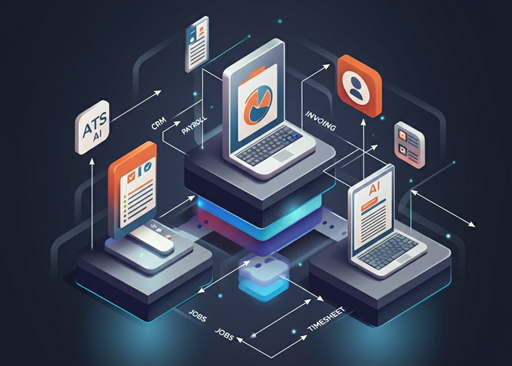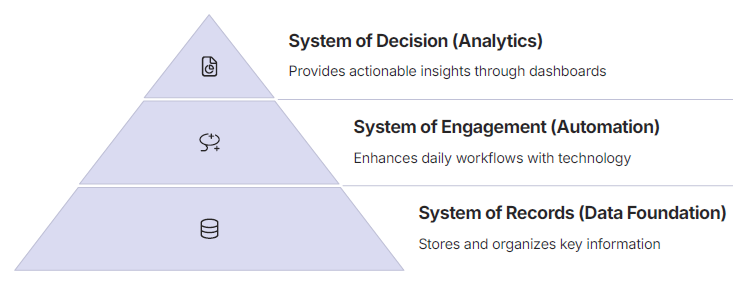
Building the Perfect Tech Stack for Your Staffing Agency
A well-designed staffing agency tech stack is the backbone of modern staffing agencies. It keeps operations smooth, efficient, and capable of scaling with growing industry demands. But what exactly is a tech stack, and why is it crucial for your business?
A tech stack is a collection of technologies and tools layered together to support business functions. Each layer works harmoniously to automate tasks, streamline workflows, and enhance decision-making.
For a staffing agency, where time-sensitive operations like recruiting, onboarding, and payroll dominate, having a robust staffing agency software solution isn't just a competitive advantage—it's a necessity.
Understanding the Three Layers of a Tech Stack
Every efficient tech stack has three foundational layers. Each layer is critical in supporting different aspects of your staffing agency operations and ensuring seamless workflows.

1. System of Records (Data Foundation)
- Stores and organizes key information such as candidate profiles, client data, and placement history.
- Examples: Applicant tracking systems (ATS), HR management platforms.
- Essential for maintaining accurate, easily accessible data to support recruiting and compliance.
2. System of Engagement (Automation)
- Enhances daily workflows with recruitment technology like CRMs, email systems, and integrated calendars.
- Automates repetitive tasks to improve collaboration between staff, clients, and candidates.
3. System of Decision (Analytics)
- Provides actionable insights through dashboards and staffing analytics tools.
- Tracks KPIs, measures success rates, and guides data-driven decision-making.
Together, these three layers form the core of a high-performing tech stack for staffing firms.
Key Areas to Address When Building Your Tech Stack
Recruiting |
Use recruitment automation tools to create a seamless experience for new talent. |
Onboarding |
Automate background checks, document collection, and compliance with onboarding automation |
CRM |
Implement a recruitment CRM to manage client and candidate relationships, communications, and follow-ups. |
Job Management & Scheduling |
Create a mobile app for crew self-service. This app will let workers choose jobs and match them using automated tools and AI. |
Timesheets |
Digitalize timesheet tracking for transparency, timely approvals, and precise client billing. |
Payroll |
Use reliable payroll software for staffing agencies to automate calculations, tax filings, and early wage access. |
Compliance |
Invest in compliance-focused tools to meet regulatory standards, especially in industries like healthcare. |
Reporting & Analytics |
Leverage staffing analytics tools to pull insights from sourcing channels, fill rates, and client satisfaction. |
Self-Service Options |
Empower users with self-service staffing portals for profile updates, job postings, and application tracking. |
Accounting Systems |
Optimize invoicing, payment tracking, and cash flow management with integrated accounting tools. |
Workflow Automation |
Deploy workflow automation for staffing to handle routine notifications, task assignments, and processes. |
Task Management |
Use task management for staffing agencies to prioritize work, assign responsibilities, and monitor deadlines. |
Consequences of Not Having a Proper Tech Stack
1. Inefficiency Across Operations
Without automation, teams spend excessive time on manual tasks like resume processing or compliance.
2. Higher Risk of Errors
Manual processes increase the chance of errors, which could damage your reputation or lead to penalties.
3. Poor Client and Candidate Experience
Outdated staffing and recruiting software systems lead to frustration and push talent toward competitors.
4. Difficulty Scaling Operations
Disconnected systems hinder growth, causing bottlenecks as the talent pool and client base expand.
5. Falling Behind the Competition
Agencies using advanced recruitment technology gain speed, accuracy, and trust over outdated firms.
6. Missed Opportunities
Without analytics, agencies miss valuable insights that could boost performance and reduce costs.
Choosing the Right Technologies for Your Tech Stack
1. Business Type
Match your tech stack to your industry; for example, healthcare staffing needs compliance-focused tools.
2. Client Requests
Listen to client needs—whether it's detailed analytics, self-service staffing portals, or custom reports.
3. Company Skillset
Choose tools your team can manage effectively without heavy training requirements.
4. Existing Systems
Ensure new tools integrate well with your current staffing software to avoid operational disruption
5. Current Vision
Align technology investments with today’s business goals and workflow strategies.
6. Future Vision
Select scalable technologies that evolve with your staffing agency’s future plans, including automation and self-service.
How to Get Started
1. Identify Your Bottlenecks
- Evaluate which processes in your staffing operations cause the most delays or inefficiencies. These are strong candidates for optimization through staffing agency software.
2. Determine Which Processes Should Be Automated
- Look for repetitive, time-consuming tasks—such as shift scheduling, timesheet approvals, or candidate communication—that don’t require human judgment. These are ideal for automated staffing solutions.
3. Gather Feedback from Your Team
- Your internal staff are daily users of your systems. Understanding their pain points and preferred features will guide better decisions when building your tech stack for staffing.
4. Collect Client Requirements
- Clients often expect faster placements, better reporting, or easier communication. Use their input to select technologies that improve the client experience and streamline staffing operations.
5. Identify Growth Barriers
- Determine what’s currently limiting your staffing agency’s growth. Whether it’s poor scalability, limited visibility, or manual errors, the right technology can eliminate these obstacles.
6. Prioritize Real-Time Data Needs
- Access to live data—such as candidate availability, job status, and performance metrics—can significantly improve decision-making. Ensure your staffing software stack supports real-time reporting.
7. Evaluate Existing Systems to Retain
- Not all legacy tools need to be replaced. Find out which systems work well. These can be added to your modern tech stack. This will help protect past investments and reduce disruption.
8. Define Your Competitive Differentiators
- Consider how technology can help you stand out. It can do this by speeding up hiring, improving mobile experiences, or providing better analytics. These unique offerings are your edge in a crowded staffing market.
9. Assess Data-Driven Decision-Making Goal
- If strategic growth depends on analytics, make sure your tech stack has strong data tools. These tools should help you understand key staffing KPIs.
10. Evaluate Opportunities to Reduce Manual Work
- Find areas where your team spends too much time on manual tasks, like data entry or onboarding. Focus on automating these tasks with integrated staffing technology solutions.
Final Thoughts
Choosing the right tech for your staffing agency is not about following trends. It’s about picking tools that deliver real results. With the right mix of staffing software, recruitment tools, and automation, your agency can grow. You will provide great service and lead the future of staffing.
Invest thoughtfully today to build a stronger, more innovative, and future-ready staffing agency tomorrow.
FAQ:
Q1: Why is building the right tech stack important for staffing agencies?
A well-designed staffing agency tech stack improves operational efficiency, reduces errors, enhances client and candidate experience, and supports scalable growth.
Q2: What are the three essential layers of a staffing agency tech stack?
The three main parts are:
- System of Records: This is the database.
- System of Engagement: This involves automation.
- System of Decision: This includes analytics and reporting.
Q3: What should staffing agencies consider when choosing tech tools?
Staffing agencies should look at the type of business, client needs, staff skills, current systems, and future growth plans. This will help them choose the right technologies for their tech stack.
Q4: What are the risks of not having an efficient tech stack for staffing agencies?
Without a proper staffing agency software stack, agencies may face operational inefficiencies, increased errors, poor candidate and client experiences, and difficulty scaling operations.
Q5: How can workflow automation benefit staffing agencies?
Workflow automation in staffing agency technology stacks reduces manual tasks, improves productivity, enhances accuracy, and allows teams to focus on strategic initiatives.


 5.0
5.0